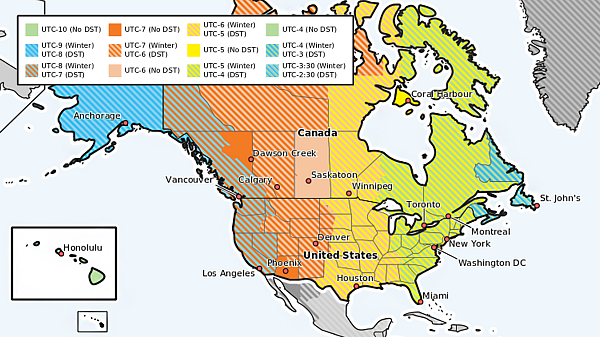USA & Canada Start DST on March 8, 2020
Most of the United States, Canada, and Mexico's northern border cities start Daylight Saving Time (DST) on Sunday, March 8, 2020.


The striped areas start DST on March 8, 2020.
©timeanddate.com
People in areas that observe DST will set their clocks forward one hour from 02:00 (2 am) to 03:00 (3 am), local time, on March 8, 2020.
Standard time, also known as winter time, will resume on Sunday, November 1, 2020.
Brighter Afternoons
In local time, sunrise and sunset will be about one hour later than the day before, resulting in more daylight in the afternoon.
Most of the US Uses DST
Almost all of the United States observes DST, except for Hawaii and most of Arizona
None of the US dependencies observe DST. This includes American Samoa, Guam, Puerto Rico, the Northern Mariana Islands, the US Minor Outlying Islands, and the US Virgin Islands.
DST in Canada
In Canada, DST begins at the same time as in the US.
Areas that don't use DST include most of Saskatchewan, some locations in Québec east of 63° westerly longitude (e.g., Blanc-Sablon), Southampton Island, and some areas in British Columbia.
Time Zone Converter: Find the time in another country
US Bills Waiting on Congress
Proposals to stay on standard time or move to full-time DST appear on the legislative agenda nearly every clock change. Since 2015, more than 200 daylight saving bills and resolutions have been introduced in almost every state across the United States, according to the National Conference of State Legislatures.
Several US states have passed bills and resolutions in favor of permanent DST. However, none have received congressional approval to abolish the time change. For this to happen, Congress first has to pass a federal law allowing states to observe DST year-round.
Which States Want to Ditch the Switch?
- On February 10, 2020, the Utah Senate voted to approve Senate Bill 59. The bill would have Utah spring ahead and stay ahead permanently, but it requires action by Congress and at least four western states before taking effect.
- On February 3, 2020, the Governor of South Carolina signed Act No. 113, intending to put the state on year-round DST if approved by Congress.
- In December 2019, the Governor of Delaware signed Senate Bill 73 to keep the state permanently on DST. The bill requires that Pennsylvania, New Jersey, and Maryland each do the same, and is awaiting congressional approval.
- In June 2019, Maine also passed into law Legislative Document 885 that would keep the state on DST permanently. This is also waiting for approval from Congress.
- The Governor of Oregon signed Senate Bill 320 for permanent DST in June 2019. However, the bill stipulates that the law will only be implemented if Washington and California approve their all-year DST policies.
- In May 2019, the governor of Washington signed House Bill 1196 in favor of permanent DST. It is also awaiting congressional approval.
- In May 2019, Tennessee governor Bill Lee signed Senate Bill 1100, establishing DST as standard time. This bill is awaiting congressional approval.
- Florida's 2018 bill for permanent DST, dubbed the Sunshine Protection Act, is awaiting congressional approval.
- In California, Assemblymember Kansen Chu's DST bill has been pushed to 2020. In 2018, 60% of Californians voted in favor of permanent DST in Proposition 7.
DST might become history in the European Union
Mexico DST Divided
A few northern Mexican border towns, such as Tijuana and Juárez (Ciudad Juárez), start DST on March 8, along with the US and Canada.
However, most of Mexico starts DST on Sunday, April 5, 2020. Some regions of Mexico, including cities like Hermosillo and Cancún, do not observe DST at all.
Other areas starting DST on March 8 are Cuba, Bermuda, the Bahamas, Saint Pierre and Miquelon, and Thule Air Base in Greenland.
Set Clocks Back or Ahead?
To remember which way to set your watch, keep in mind one of these sayings: “spring forward, fall back” or “spring ahead, fall behind.” The clocks spring ahead (= losing one hour) in the spring when DST starts and fall behind one hour (= gaining one hour) when DST ends in the fall.